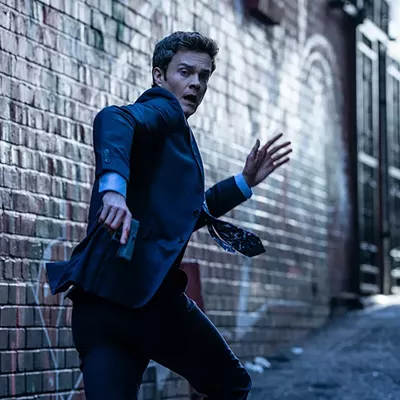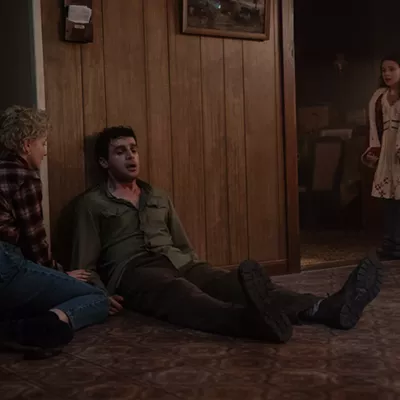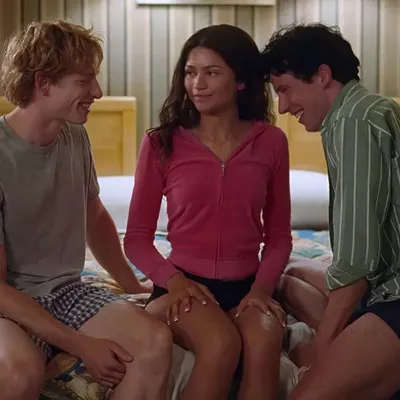In sum: Drugs are bad. Real bad. They can make your arm fall off, or ruin your chances of appearing on television, or cause you to have double-ended dildo sex for money. So don't do drugs. Only losers and extremely beautiful people like Jared Leto and the incomparably breathtaking Jennifer Connelly do drugs. So drugs either make you a loser or a really pretty person, but one who doesn't feel so good. So now you know the basic message, and you can skip the film.
Unless ... you want to see something that is utterly, technically amazing. Requiem is perhaps the most painstakingly constructed film you'll ever see. There are over 2,000 edits in this movie; the average modern film has about 600.
And every edit is perfect. Every shot looks like it was composed by Vermeer, photographed by Man Ray and animated by Tex Avery. If it were possible to view this film without being subjected to the brutal storyline and somewhat simplistic worldview it puts forward, it would probably be the best aesthetic experience you'd have all year.
Sadly, the real world seldom works that smoothly. The movie tells the story of Sara Goldfarb (Ellyn Burstyn), an elderly woman living alone near Coney Island. Her son Harry (Jared Leto) comes to visit her whenever he needs to steal her television to support his drug habit. Strangely, in spite of the fact that he has no cash to pay for his heroin, he lives in a spacious apartment that's loaded with sound equipment so he can make his own scratch mixes while rushing on smack.
He shares the place with his junky pal Tyrone (Marlon Wayans), and with his unbelievably beautiful junky girlfriend Marion (Jennifer Connelly).
Of course, if you put two people who look as good as Jared Leto and Jennifer Connely together in a shot, you're not going to have to worry about a blurry image or shaky camera ruining people's enjoyment of the visuals. Nonetheless, director Darren Aronofsky and cinematographer Matthew Libatique put an insane amount of thought and effort into the composition and construction of each moment of each shot.
Some of the force of their effect is created by recurring series of images. For example, each time the junkies shoot up the scene switches rapidly from an extreme close-up of the heroin cooking, to an extreme close-up of the needle filling up, to a microscopic shot of a blood vessel, to a close-up of a pupil dilating. The sequence is put together with such precise rhythm that it becomes the visual equivalent of music, a kind of filmic refrain that is utterly engrossing each time it appears.
Of course, it's also matched perfectly to the film's soundtrack, with the sounds punctuating each cut and image.
While Harry and Marion get high, Harry's mother gets a call claiming to be from a company that selects contestants for TV game shows. Her whole life is dedicated to watching television, so the chance to appear on it is the greatest thrill she could ever have. In preparation for what she believes will be her big moment, she goes on a diet, but, unable to stick to it, resorts to a shady diet doctor who gets her strung out on speed and downers.
As Harry tries to clean up his act, his mother gets deeper and deeper into addiction, and her story is devastating. On the old Second City TV series there used to be a cheesy horror-movie host named Count Floyd. Count Floyd would often end up showing the wrong film, and once he played Ingmar Bergman's Hour of the Wolf, thinking it was a werewolf film. Afterwards, he noted that it was much scarier than a horror movie, because it was about loneliness, and nothing is scarier than loneliness.
Aronofsky takes this idea to its extreme, treating Sara Goldfarb's loneliness with the style of classic horror film. Her refrigerator comes to life, her television laughs at her, and her house seems to attack her as she tries to fight off despair. It's intensely horrifying, but Aronofsky doesn't know when to quit.
Things go from worse to whatever it is that's worse than worse for all of his characters as their addictions take over their lives. The final sequence, which in itself contains over a hundred cuts, is a rhythmic flashing of the most degrading images you'd ever want to see on film.
In watching Requiem, you'll cringe when you're supposed to cringe. That, in itself, does show Aronofsky's prowess. It doesn't show his maturity. That he can make an audience dance to the complicated rhythms of his simplistic tune is a sign of good things to come, but simply showing despair and making an audience feel it isn't the same thing as having a deep understanding of humanity, which is what this movie seems to call for. It's devastating, it's stunning to watch, and it's hard to notice it while you're being jerked out of your seat by the terrors on the screen, but underneath it all Requiem is a bit shallow.
Requiem For A Dream is playing at Catalina (881-0616).









